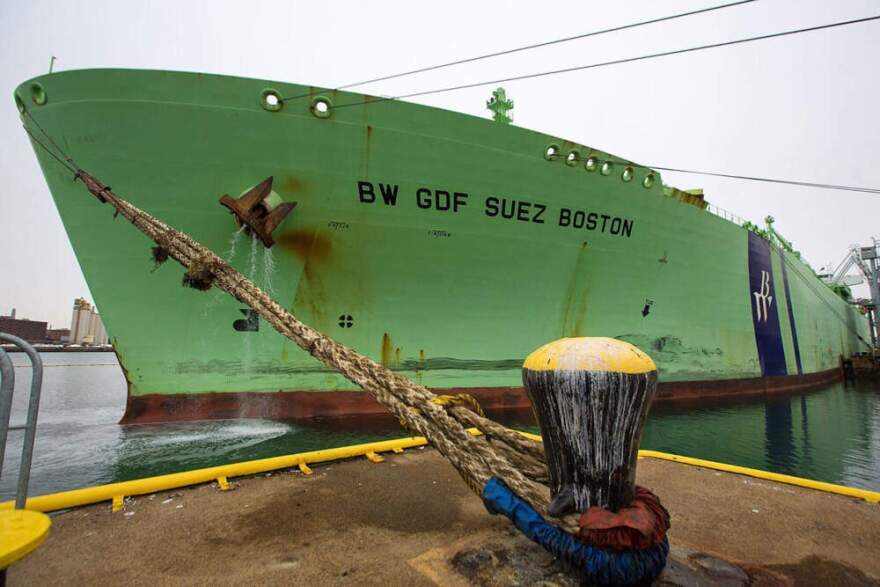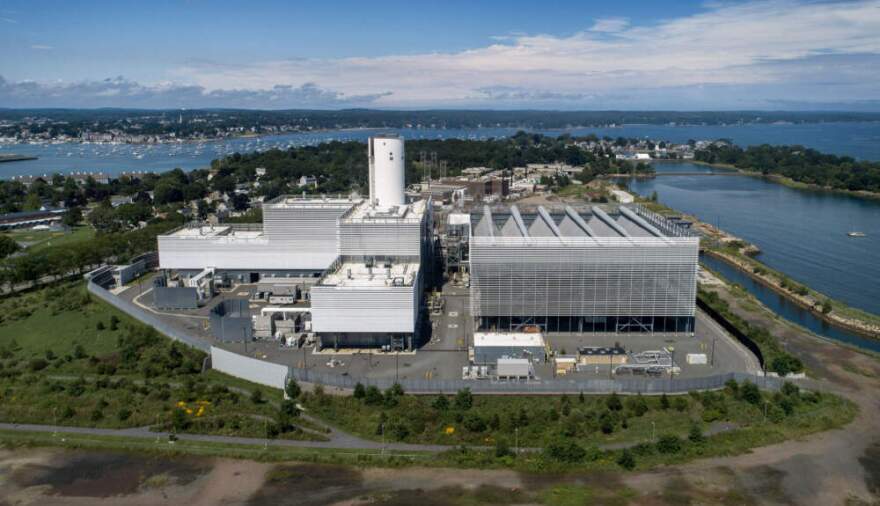New England is at an energy crossroads: Demand for electricity is expected to rise for the first time in nearly 20 years. Offshore wind and other renewables aren’t being built at the speed and price once predicted. And many people still have sticker shock after a winter of exceptionally high utility bills.
This confluence of challenges — plus a federal administration that’s hostile to renewables and pushing hard for more oil and gas use — has some residents and policy makers re-examining an option that’s been out of favor for several years: a new natural gas pipeline.
“I’m having lots of conversation about natural gas,” said Dan Dolan, president of the New England Power Generators Association, a trade association that represents most power generators in the region. “The conversation is different now than it was a few months ago.”
Proponents of a new pipeline, like Connecticut Gov. Ned Lamont and New Hampshire Gov. Kelly Ayotte, say it would reduce energy prices, make the electricity system more reliable and bolster economic growth.
But critics, like Massachusetts Gov. Maura Healey and many environmental advocates, say it would be a short-sighted investment that would derail the region’s climate plans and raise energy prices in the long-run. Instead, they say, New England should focus on building renewables and big batteries, as well as trying to reduce peak electric demand.
The pipeline debate is playing out in public forums, op-ed pages and social media, dividing the public and policy-makers alike. Even President Trump has weighed in, arguing in favor of a new pipeline.
“The most expensive energy, almost, in the world is in New England, because they have no way of getting it there,” Trump said earlier this year.
While there’s no specific pipeline project under consideration — and only distant proposals in the works — it’s clear is that whatever choice the region makes will shape the energy landscape and the prices people pay for decades to come.
The case for a new gas pipeline
Those pushing for a new gas pipeline into New England make a straightforward, Econ. 101 argument: New England uses a lot of gas to generate electricity and heat buildings. And demand often outstrips supply during peak hours, which makes prices high. Bring in more supply and prices will go down.
“It’s really that simple,” said Paul Craney, executive director of the Mass Fiscal Alliance. “If you allow more supply into the region, when we have these peaks, they’re not as painful.”
New England has some of the highest natural gas prices in the U.S. because it doesn’t have any local oil or gas reserves and sits at the end of the country’s pipeline network. The existing pipes generally deliver enough to meet demand for home heating and electricity. But when demand spikes on really cold days, the pipelines max out and prices rise even more, said Arvind Ravikumar, an energy researcher at the University of Texas at Austin.
“The ability of natural gas to be delivered to New England is very constrained,” he said. When demand peaks, and the pipelines are operating at full capacity, “it’s not enough to meet demand for natural gas.”
Instead, the region turns to expensive alternatives like importing liquified natural gas and burning oil to generate electricity.

“A new pipeline would allow more natural gas to reach us in periods when we really need it,” said Christopher Knittel, a professor of applied economics at MIT. “So that’s where the big savings would be.”
In non-peak times, Knittel said a new pipeline would put downward pressure on prices too — especially if it connected to the Marcellus Shale, the enormous gas reserve that runs under parts of Pennsylvania, New York, Ohio and West Virginia.
“We would have better access to just cheaper gas, generally,” he said, “which would have kind of a more constant effect on natural gas prices.”
For months, Trump has made this argument as he pushes to revive the Constitution Pipeline, a proposal to bring gas from the Marcellus Shale to Albany, New York, where it would connect with pipelines that feed New York City and New England. The project was canceled in 2020 after failing to get key environmental permits, but is now back on the table, according to its developer.
While the pipeline could make it easier to get inexpensive gas to the region, some experts said it wouldn’t solve New England’s capacity problems on the coldest days of the year.
In other words, simply sending more gas to the region doesn’t mean it can get where it’s needed most during periods of high demand.
Developers in the past have tried to address this issue with proposals to bring more gas directly to the Boston area, but those endeavors were shelved because there wasn’t a clear way to finance them. The latest attempt, Project Maple, is still in the earliest stages of development.

If one of these projects, or something similar, were to materialize and relieve some of the pipeline constraints in the region, it could provide short-term relief for high utility bills, Ravikumar said.
But, he added, the long-term benefits are less certain.
Whether ratepayers would come out ahead in the long-term hinges on factors like the size and location of a given project, conditions in the global gas market and what happens to the cost of renewables and other more climate-friendly technologies, said Richard Levitan, president of the Boston-based energy consulting firm, Levitan and Associates.
“It depends on the assumptions one makes,” he said. “There’s no way to crystal ball it.”
The case against a new gas pipeline
On the other side of the debate are those who say a new gas pipeline is simply a bad investment — for energy prices and the planet.
“There really is no economic case for expanded gas pipeline capacity in the region, and that’s because we think consumers are going to be left worse off as a result,” said Jamie Dickerson, senior director for climate and clean energy programs at the Acadia Center, a Boston-based research and advocacy nonprofit.
While there hasn’t been a new interstate pipeline into New England in a long time, several developers have expanded the diameter of some existing pipes and built new compressor stations to push more gas through. Since 2014, the total capacity on major pipelines into the region has increased 51%, Dickerson said. And during that time frame, the cost of gas has gone up for utility customers.
Kyle Murray, Massachusetts program director at the Acadia Center, had a challenge for anyone supporting new pipeline along economic lines.
“ I would say, ‘Prove your case, show your math,’” he said. “Because I don’t think the math bears out.”

Dennis Wamsted, an energy analyst at the nonpartisan Institute for Energy Economics and Financial Analysis, further cautioned that building a new pipeline could lead to higher utility bills because the cost of gas is unpredictable.
For many years following the “fracking boom” of the early 2000s, gas was plentiful and cheap in the U.S. But in the last few years, domestic gas producers have increasingly liquefied and exported their gas to make more money. The result has been higher prices and a stronger tie to the global market price.
“That just makes the whole system in the U.S. much more vulnerable to price spikes and volatility,” Wamsted said. He noted that this dynamic was on full display in 2022, when gas and electric prices rose dramatically following Russia’s invasion of Ukraine.
Anyone arguing that a new pipeline will lead to lower overall costs for consumers is making “a huge leap of faith,” Wamsted said.
Investing in a new pipeline could be also be risky because many states in the region are working to decrease their dependence on natural gas, said Liz Stanton, executive director and principal economist at the Applied Economics Clinic.
“It’s important to think about the lifetime of the pipeline,” she said. “It’s really hard to see how given existing state laws, that doesn’t become a stranded asset in 15-20 years.”
Looming over this debate is the cost of continuing to emit planet-warming emissions. Though not directly factored into monthly energy bills, there is a steep cost to climate change, said Knittel, the MIT professor.

Extracting, transporting and burning natural gas emit a lot of methane and carbon dioxide, which exacerbate the extreme — and often destructive — weather the region has experienced over the last few years. In July 2023 alone, a series of flash floods in New England caused more than a billion dollars in damage, according to the National Oceanic and Atmospheric Administration.
“Building a pipeline is almost surely going to lead to more greenhouse gas emissions,” Knittel said. “And that’s the unpriced externality here.”
Keeping the lights on
Wherever you land in the debate over a new pipeline, one thing is clear: New England will need more electricity in the future. Demand is expected to rise about 1.8% annually over the next decade, thanks largely to the adoption of electric vehicles and heat pumps. That rate could be even higher if energy-hungry data centers start popping up in the region.
What’s less clear is where this power will come from.
Charles Dickerson, president of the Northeast Planning Coordinating Council, an organization that promotes electric reliability in New England, New York and Eastern Canada, said the most realistic way to meet this new demand is to increase the gas supply.
Dickerson said he knows the idea of a new gas pipeline isn’t popular in clean energy and environmental circles, but after his organization did a two-year study about how gas constraints could affect New England’s grid during a prolonged cold snap, this is the conclusion he’s come to.
“More gas infrastructure is likely needed,” he said.
Other experts see a different path forward. Wamsted, from the Institute for Energy Economics and Financial Analysis, said the region should invest in technologies that can reduce peak electricity demand and double-down on renewables — which can be faster and cheaper to build than gas pipelines.
A new gas pipeline would take years to design, permit and construct, and would almost certainly face court battles because “nobody actually wants those gas lines to go through their town or their state forest or their backyard,” Stanton, the economist, said.
What’s more, there’s a waitlist of up to seven years for the turbines required to build new gas-fired power plants, meaning a new pipeline wouldn’t translate to more electricity until sometime in the 2030s.

If ratepayers in the region are going to pay for energy infrastructure to bolster the supply of electricity in the short-term and help control costs, Dickerson, of the Acadia Center, said they’d be better off funding more electric transmission lines, like a project in Maine slated to come online later this year.
“If there’s a desire to spend a billion dollars on linear infrastructure,” he said, “I think there’s no doubt about it that transmission is going to be a wiser course than a gas pipeline.”
Yet, as policy-makers and the public weigh whether to build a new pipeline, Dolan of the New England Power Generators Association, said right now, it’s largely “an academic question.”
The reason: It’s unclear how any pipeline developer would finance a project.
Even if a company wanted to build a pipeline, it would need to find someone willing to sign long-term contracts for the gas. And right now, potential buyers like utilities and power plant owners are uninterested or unable to ink that sort of deal, according to Dolan.
“ The president could direct the Army Corps of Engineers to dig a trench from the Marcellus Shale fields to Boston,” Dolan said. “And unless there is a counterparty in Boston willing to sign a 20- or 30-year contract with the pipeline operators, I don’t know a single pipeline company that will lay an ounce of steel in the ground.”
This article was originally published on WBUR.org.
Copyright 2025 WBUR




